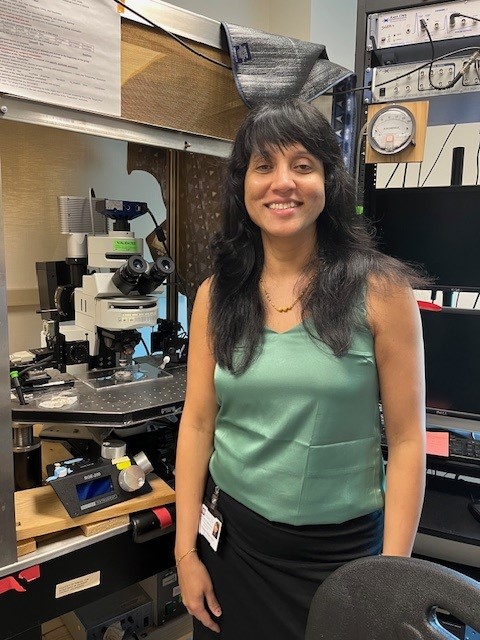Punam Pokam, PhD

Assistant Professor
Contact
Department of Neuroscience & Experimental Therapeutics
8447 John Sharp Pkwy
Bryan,
TX
77807-3260
punam.pokam@tamu.edu
Phone: tel:979-436-0315
Research Interests
- Pokam's team investigates how traumatic brain injury (TBI) affects neuronal intrinsic and synaptic mechanisms, and how those factors influence dysfunctional brain excitability, such as epilepsy and spreading depolarization, after a TBI. Large numbers of the U.S. population, including civilians and the military, suffer from brain injuries, making the impact of TBI research tremendous. Notably, edema is one of the most prominent secondary injuries associated with TBI, one that can be observed within minutes and persist for days; because it is the principal cause of death following TBI, it is a crucially important target for intervention and unfortunately is still confronted with decades-old primary treatments that yield little success. Her recently published work in the Journal of Clinical Investigation shows that neuronal edema after TBI may not be harmful under all circumstances and can actually increase excitability when suppressed at certain time points. This has potentially major clinical implications, as the current clinical priority still centers around eliminating edema at all costs. Currently, her team is examining sex-based physiological differences in neuronal edema that may contribute to the greater burden of brain excitability after traumatic brain injury in females.
- In addition, the team is interested in understanding the cellular mechanisms of spreading depolarization (SD; also known as cortical spreading depression), a massive excitable event that is recognized as the pathological correlate of neurologic diseases such as TBI and subarachnoid hemorrhage. Notably, SDs have emerged not only as a pathological target for therapies but also as a potentially useful biomarker for brain injuries. The team investigates how SDs ignite and how different cell types (neurons and astrocytes) are involved in this process. By determining the mechanisms driving SD initiation, they can target upstream pathways to mitigate the occurrence of SDs.
- The team leverages a multifaceted approach to research in the laboratory, including in vivo whole-cell electrophysiology, two-photon microscopy, and brain slice electrophysiology. Her lab is the first ever to deploy in vivo whole-cell recording following a brain injury, enabling a mechanistic assessment of intrinsic, synaptic, and network behaviors in intact animals—work that was previously impossible in TBI models.
- Pokam takes the training of undergraduate, graduate, and postdoctoral students seriously. She is highly committed to helping provide the mentorship and training environment students need to be successful.
- Research in her lab is supported by NIH R01 and R21 grants.
Representative Publications
- Sawant-Pokam Punam, Vail Tyler, Metcalf Cameron, Maguire Jamie, McKean Thomas, McKean Nick, and Brennan KC. Preventing neuronal edema increases network excitability after traumatic brain injury. The Journal of Clinical Investigation, 130(11), 6005–6020, 2020.
- Sawant-Pokam PM, Suryavanshi P., Mendez JM., Dudek FE., Brennan KC. Mechanisms of neuronal silencing after cortical spreading depression. Cerebral Cortex, 2017; 1-15.
- Suryavanshi Pratyush, Sawant Pokam Punam, Clair Sarah, Brennan KC. Increased presynaptic excitability in a migraine with aura mutation. Brain, 147(2): 680-697, 2023. PMID: 37831655.
- Sawant PM, Tyndall JDA, Holland PT, Peake BM, Mountfort DO, Kerr DS. In vivo seizure induction and affinity studies of domoic acid and isodomoic acids-D, -E and –F. Neuropharmacology, 2010b; 59: 129-138. Special Issue.
- Sawant PM, Mountfort DO, Kerr DS. Spectral analysis of electrocorticographic activity during pharmacological preconditioning and seizure induction by intrahippocampal domoic acid. Hippocampus, 2010a; 20: 994-1002.